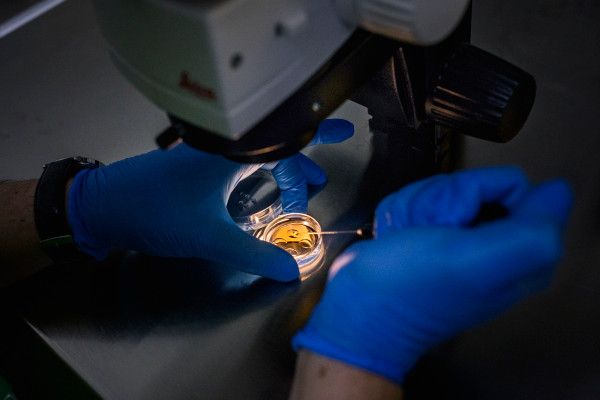The company has 55 fertility clinics across the U.S.


NASA’s intrepid Juno spacecraft has been probing and documenting the Jovian system since it first arrived back in July of 2016, after a five-year journey from Earth. While we’ve all seen many of the remarkable photos its instruments and cameras have recorded as it circles the planet, it’s still far removed from the sheer immensity witnessed firsthand by the probe.
To offer up a front row seat aboard Juno, a new five-minute flyby video, comprised of 41 separate images recorded by the craft, delivers a small glimpse of what we’d observe if we were a stowaway passenger as it passed over the gas giant at a range of approximately 2,100 miles above the cloudtops.

According to new research from CCR scientists, embryonic stem cells have a unique way of protecting their telomeres, the structures at the ends of chromosomes that shorten with every cell division. A research team led by Eros Lazzerini Denchi, Ph.D., an NIH Stadtman investigator in CCR’s Laboratory of Genomic Integrity, has found that rather than treating exposed telomeres as damaged DNA as most cells do, embryonic stem cells call on genes typically used only during the earliest stage of development to stave off unwanted DNA repair. The team’s findings, which come from studies of mouse embryonic stem cells, are reported November 25, 2020, in Nature.
By revealing an unexpected way cells can protect their telomeres, the new findings may help explain a survival strategy employed by some cancer cells, which must find a way to circumvent growth limits imposed by the natural shortening of telomeres that occurs as we age.
Embryonic stem cells, which arise early in an embryo’s development, have a unique capacity to become virtually any of the body’s specialized cell types. Lazzerini Denchi and colleagues first discovered their unusual approach to protecting telomeres when they found that the cells can survive without a protein called TRF2, which binds to and protects chromosome tips. The protein is absolutely essential for hundreds of different types of cells. Without it, exposed chromosome tips trigger faulty activation of DNA damage repair pathways, which stitch the unprotected ends together. Chromosomes fuse together and cells lose the ability to divide. But when Lazzerini Denchi’s team removed TRF2 from embryonic stem cells, chromosomes maintained their integrity and the cells continued to proliferate.

Scientists have established a new method to image proteins that could lead to new discoveries in disease through biological tissue and cell analysis and the development of new biomaterials that can be used for the next generation of drug delivery systems and medical devices.
Scientists from the University of Nottingham in collaboration with the University of Birmingham and The National Physical laboratory have used the state-of-the-art 3D OrbiSIMS instrument to facilitate the first matrix- and label-free in situ assignment of intact proteins at surfaces with minimal sample preparation. Their research has been published today in Nature Communications.
The University of Nottingham is the first University in the world to own a 3D OrbiSIMS instrument. It is able to facilitate an unprecedented level of mass spectral molecular analysis for a range of materials (hard and soft matter, biological cells and tissues). The facility in Nottingham also has high pressure freezing cryo-preparation facilities that enable biological samples to be maintained close to their native state as frozen-hydrated to complement the more commonly applied but more disruptive freeze drying and sample fixation. When the surface sensitivity, high mass/spatial resolution are combined with a depth profiling sputtering beam, the instrument becomes an extremely powerful tool for 3D chemical analysis as demonstrated in this recent work.

These findings […] strongly suggest that high levels of iron in the blood reduces our healthy years of life, and keeping these levels in check could prevent age-related damage.
Genes linked to ageing that could help explain why some people age at different rates to others have been identified by scientists.
The international study using genetic data from more than a million people suggests that maintaining healthy levels of iron in the blood could be a key to ageing better and living longer.
The findings could accelerate the development of drugs to reduce age-related diseases, extend healthy years of life and increase the chances of living to old age free of disease, the researchers say.
Electric RV. Now with an energy-efficient thermal rating construction & revolutionary energy supply, the ERV can truly enhance your caravanning experience.


One of Lockheed Martin’s top directed energy minds explains how breakthroughs in communications and industrial tech made laser weapons possible.

Scientists find that A. echinatior ants have biomineral armour to help them in battle with other ants and protect them from pathogens. 😃
Ants are pretty organised little creatures. Highly social insects, they know how to forage, build complicated nests, steal your pantry snacks, and generally look after the queens and the colony, all by working together.
Leaf-cutter ants turn that cooperation up several notches. Leaf-cutter ant colonies like Acromyrmex echinatior can contain millions of ants, split into four castes that all have different roles to maintain a garden of fungus that the ants eat.
These farming ants might make a top-tier team of gardeners, but that doesn’t mean they don’t get into the occasional scrap, and living in such large groups usually also means facing an increased risk of pathogens.